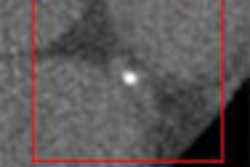A new study by Australian researchers has found that the radiation dose delivered in computed radiography (CR) examinations could be cut in half by adjusting the manufacturers recommended range (MRR) for exposure indices (EIs) by as little as 10%.
The arrival of CR has given radiographers (radiologic technologists) the ability to use a greater range of radiation exposures to produce diagnostic images, the article states. Because, unlike film-screen radiography, higher-than-appropriate exposures in CR result in better-quality images due to increased signal-to-noise ratio, and "radiographers develop a tendency to use higher than necessary exposure factors to improve image quality and avoid repeat radiographs."
To safeguard against overexposure, CR manufacturers each set their own exposure indicators -- numerical parameters that are estimates of radiation exposure on imaging plates. The feature is called EI on systems manufactured by Eastman Kodak Health Group of Rochester, NY, and sensitivity value (S) on units made by Fujifilm Medical Systems of Tokyo.
Dr. Helen Warren-Forward and colleagues at the University of Newcastle set out to explore whether radiographers were in fact producing images using EIs within the MRR. They also sought to investigate any evidence of "exposure creep," and the relationship between EIs and radiation dose using fixed and varying tube potential, in the hope that this knowledge would ensure the use of techniques that minimize radiation dose. The study was published in the British Journal of Radiology (January 2007, Vol. 80:949, pp. 26-31).
The researchers retrospectively assessed CR data for posteroanterior (PA) chest and lateral (LAT) lumbar spine imaging, from two hospitals, denoted as hospital A and hospital B, using the CR-800 and CR-850 systems (Eastman Kodak), during an 18-month period from January 2004.
The researchers selected PA chest data because, in Australian hospitals, this is the most frequently performed examination. LAT lumbar spine data were selected because the researchers felt this represented a high entrance surface dose examination. Also, these two examinations provided a contrast in exposure factors, body part, and positioning technique, they stated.
Although manufacturers of CR equipment recommend certain "exposure indicators," the researchers highlighted that higher tube potentials and lower mAs reduce patient radiation dose compared with lower tube potentials and higher mAs. "Therefore, it cannot be assumed that there is a good correlation between exposure index and patient doses," they wrote.
Using a lung/chest phantom (model CNR/R5330, Oxford Scientific, Silverwater, Australia), the researchers showed that for a fixed tube potential (125 kVp), without any change in other parameters, EI correlates with entrance-surface dose (ESD) -- there is a log relationship in dose and EI in CR. So, a small increase in EI results in a large increase in ESD. Additionally, the researchers investigated the relationship among a varied tube potential, EI, and patient dose. They found that an increasing tube potential and a decreasing mAs for a constant EI (1500) resulted in decreasing ESD.
"The results from this current study strongly suggest that EI should not be used as an indication of ESD when comparing examinations conducted between different radiographers and institutions using different tube potentials," they wrote.
The authors caution that, particularly for chest imaging, a number of factors can affect patient dose, in particular tube potential. Therefore, EI should only be used to indicate ESD for examinations within a specific department performed by the same radiographers. They found no significant variation in EIs when they compared CR imaging during normal operational hours with after-hours services.
EIs lower than the MRR, 1700-1900 for Kodak CR systems, were successfully used for 30% of LAT lumbar spine examinations at hospital B and 38% of PA chest examinations at hospital A. "This implies that the MRR may be set too high and can be reduced to values less than 1700," they wrote.
More than two-thirds of PA chest examinations performed at hospital B, but less than one-third at hospital A, were produced with EIs within the MRR. Almost half of LAT lumbar spine examinations performed at hospital B were produced with EIs within the MRR, but almost half at hospital A were above the MRR.
Using the lung/chest phantom to produce suitable diagnostic images, EIs were 1550. The researchers suggest that since a reduction in EI by 300 results in half the patient dose, reducing MRR values from 1770-1900 to 1530-1700 (a 10% reduction) would result in significant dose savings (50%).
Exposure creep was described by the researchers as a tendency by radiographers to set higher exposures than necessary, knowing that images could be manipulated with postprocessing techniques, to achieve a suitable diagnostic image.
Results demonstrated exposure creep at hospital A, where exposure indices for LAT lumbar spine CR increased 7.1% during the 18-month period. Hospital A also showed a larger range of EIs, probably due to a higher number of patients and staff, resulting in greater variation in radiographic technique, which impacts the EI levels used to produce images, the authors suggested.
The study findings highlight the need for regular staff training on the appropriate use of CR systems and departmental quality assurance programs to ensure staff adopt the ALARA principle, to keep patient doses "as low as reasonably achievable," the researchers stated. They suggested that CR manufacturers should review the acceptable range of EIs recommended.
"The results showed that an EI of 2000 produced at 125 kVp can deliver the same patient dose as an EI of 1700 produced at 70 kVp, where the EI difference of 300 represents a doubling of dose to the detector," they wrote. "EI cannot always be used as an indicator of changes to patient dose, but that a number of other factors (predominately tube potential) need to be considered."
By Leanne McNoulty
AuntMinnie.com contributing writer
March 5, 2007
Related Reading
Korean rads find no edge for high-res CR in chest exams, January 22, 2007
Study: DR delivers lower radiation dose, November 7, 2006
U.S. hospitals find ways to take the digital x-ray plunge, October 12, 2006
Digital radiography slowly, but surely, makes its mark, July 25, 2006
Copyright © 2007 AuntMinnie.com



















